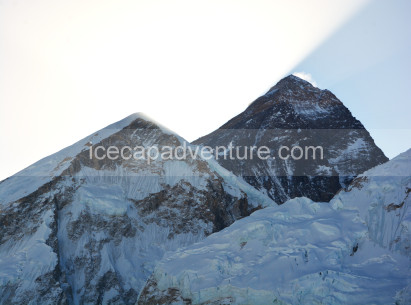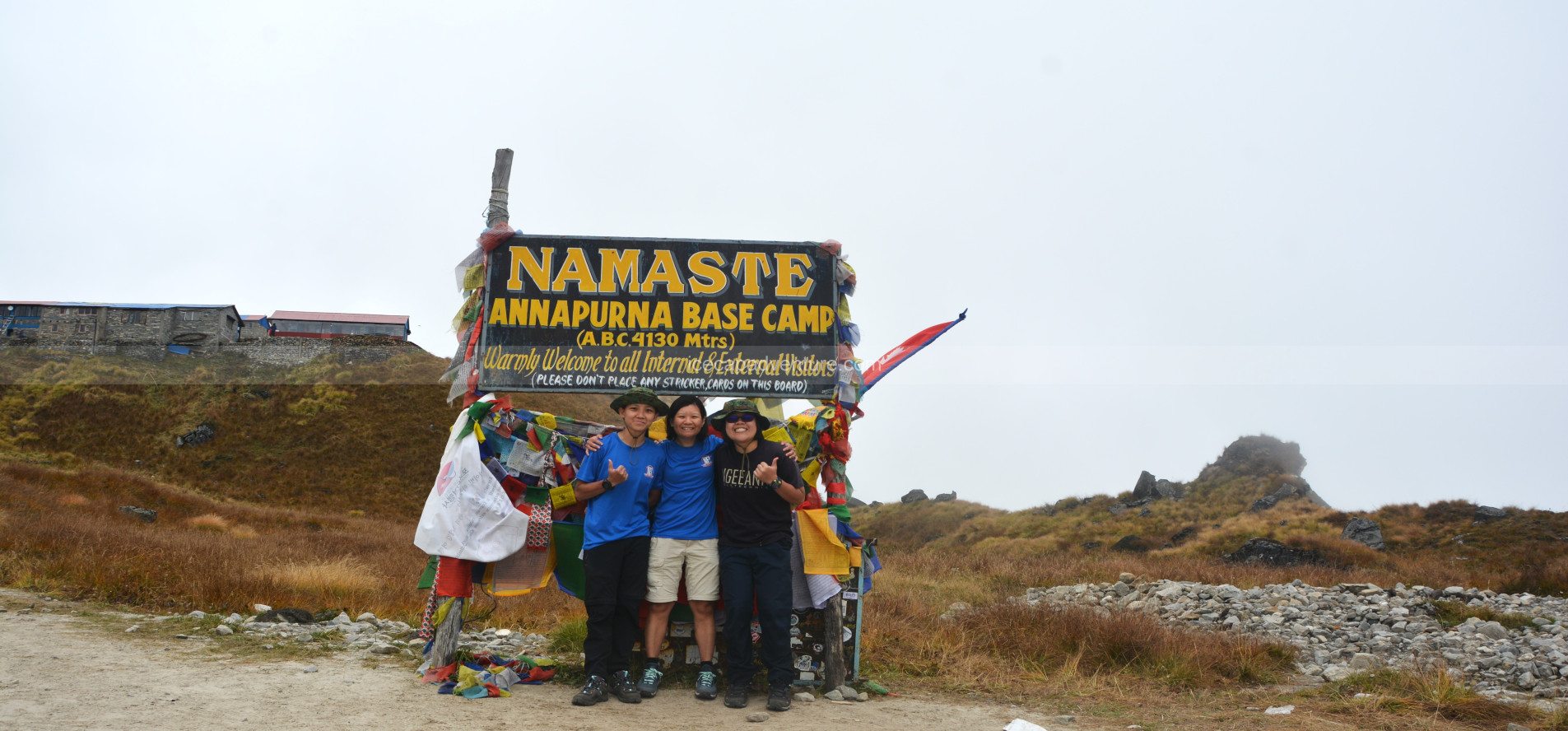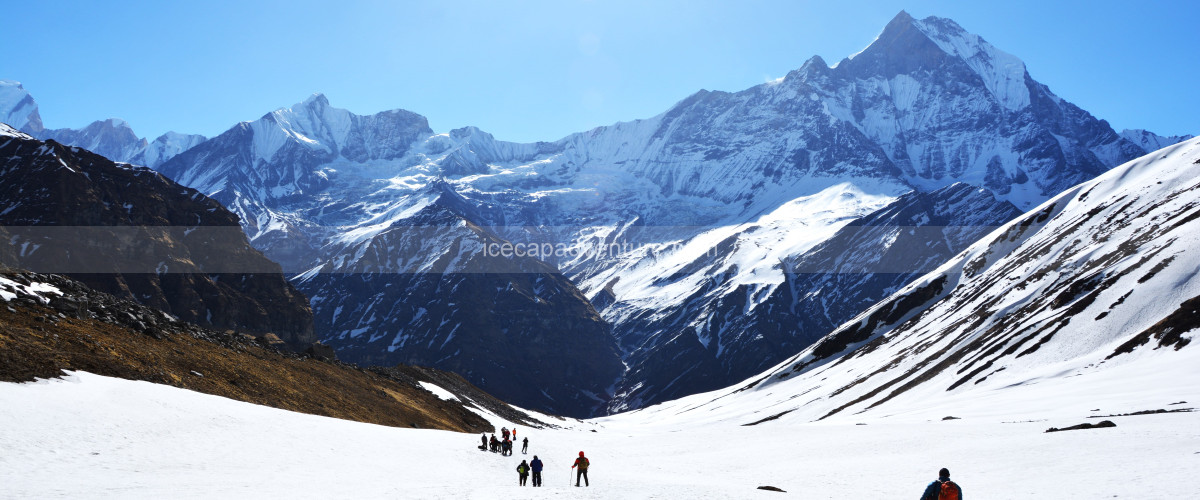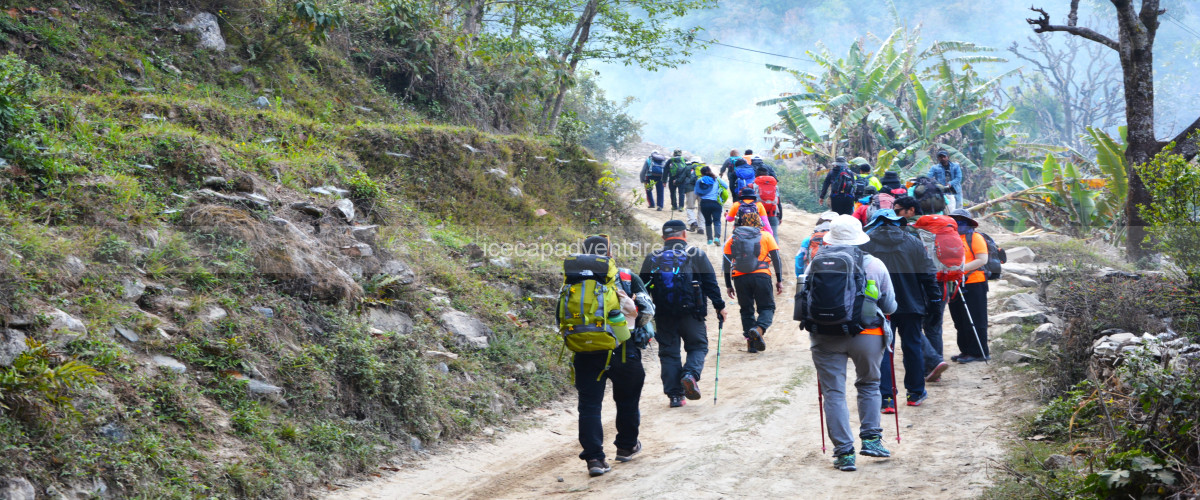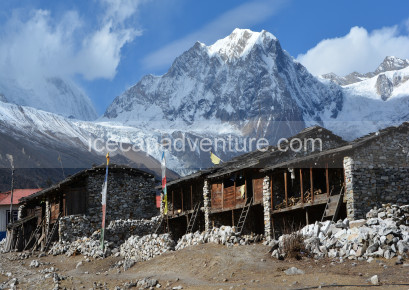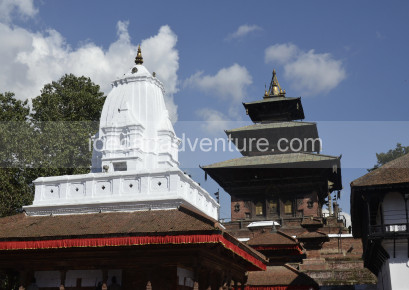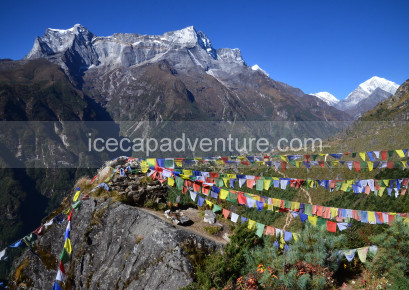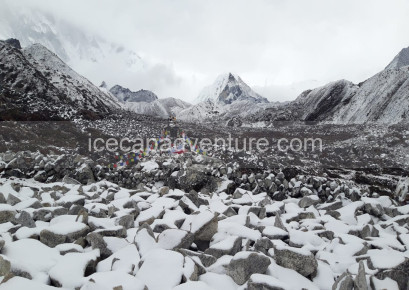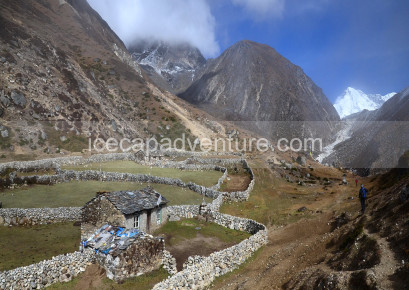.png)
.png)
.png)
.png)
.png)
.png)
.png)
.png)
Annapurna Sanctuary Trekking Overview
Annapurna Sanctuary Trekking, also known as the Annapurna Base Camp (ABC) Trek, is one of Nepal’s most iconic journeys, taking trekkers deep into the heart of the Annapurna Himalayas. Surrounded by towering peaks, the sanctuary is a natural amphitheater of mountains, glaciers, and alpine meadows, offering some of the most dramatic Himalayan scenery. This trek is perfect for those who want a combination of diverse landscapes, cultural encounters, and the thrill of standing at the base of Annapurna I (8,091m), the world’s tenth-highest peak.
Landscapes and Wildlife
The trek begins with lush terraced farmlands and subtropical forests before climbing into alpine meadows and glacial valleys. Along the trail, rhododendron and bamboo forests host langurs, Himalayan birds, and even occasional sightings of Himalayan thar. As trekkers ascend, the landscapes transform into high alpine terrain, culminating in the breathtaking Annapurna Sanctuary—a natural bowl encircled by giants such as Machhapuchhre (Fishtail), Annapurna South, Hiunchuli, and Annapurna I.
Trekking Experience
The Annapurna Sanctuary Trek is considered moderate, usually lasting 10–14 days depending on the starting point and pace. While the daily ascents and stair climbs can be physically demanding, the trail is well-marked, with abundant teahouses providing food and accommodation. At 4,130m, Annapurna Base Camp itself is not extremely high compared to other treks, but acclimatization and steady pacing are still essential. The reward—standing in the middle of towering Himalayan peaks—is unforgettable.
Best Seasons to Visit
The best times for this trek are spring (March–May) and autumn (September–November). Spring offers blooming rhododendrons and warmer weather, while autumn provides crystal-clear skies and excellent visibility. Some trekkers also enjoy the quieter winter months, though colder conditions and snow can make the trek more challenging.
Cultural Significance
The trail passes through Gurung and Magar villages, where traditional hospitality, unique architecture, and local traditions enrich the trekking experience. Small monasteries, prayer flags, and cultural festivals highlight the spiritual dimension of life in the Annapurna region.
Highlights of the Trek:
-
Reaching Annapurna Base Camp (4,130m) within a stunning mountain amphitheater.
-
Close-up views of Annapurna I, Machhapuchhre, Hiunchuli, and Annapurna South.
-
Varied landscapes: subtropical forests, alpine meadows, and glaciers.
-
Rich cultural encounters with Gurung and Magar communities.
-
Teahouse trekking with accessible facilities and warm hospitality.
1
We will be waiting to welcome you at Tribhuvan International Airport, Kathmandu, where you will be greeted with a traditional Nepali flower garland to mark your arrival. After the warm welcome, we will drive you to your hotel — approximately 30 minutes during the day and 20 minutes at night.
Upon reaching the Hotel, you will be offered welcome drinks and biscuits, followed by the settlement of your rooms. Once settled, please join us back in the lobby or meeting hall for a briefing about your trekking and tour program, including an introduction to your trekking guide and other relevant details.
After the briefing, you will have the opportunity to check your trekking equipment with your guide, and we will also explain the Annapurna Sanctuary Trek.
Note: If you arrive in Kathmandu at night, these activities will be scheduled for the following day after breakfast and meals.
.png)
.png)
.png)
.png)
2
After breakfast at the hotel, You will have time to explore Kathmandu’s cultural heritage sites such as Kathmandu Durbar Square, Swayambhunath (Monkey Temple), or Boudhanath Stupa and you will have the day to prepare for your trek.
Our team will assist you in checking your gear and ensuring you have all the necessary equipment for the journey ahead. If you need to buy or rent any trekking gear, we will guide you to the best shops in Thamel, where you can find quality items at reasonable prices.
In the evening, your trekking guide will conduct a final briefing about the trek, including route details, safety measures, and expected weather conditions. Overnight stay at a hotel in Kathmandu.
.png)
.png)
.png)
.png)
3
The drive from Kathmandu to Pokhara (200 km, 6–7 hours) offers an incredible journey through Nepal’s heartland. Traveling along the Trishuli River and through picturesque hill towns, you’ll pass terraced fields, green forests, and traditional villages. The Prithvi Highway, though winding, provides stunning views and plenty of scenic rest stops. With changing landscapes and cultural glimpses along the way, this road trip is the perfect start to your Pokhara adventure.
Highlights Along the Way:
-
Follow the Trishuli River, offering beautiful views of fast-flowing rapids and suspension bridges.
-
Pass through charming hill towns and farming villages, including Malekhu (famous for local fish) and Mugling.
-
Enjoy stops at local highway restaurants ("daal bhat" stops) offering fresh Nepali meals and tea.
-
Marvel at the terraced rice fields and subtropical forests blanketing the hillsides.
-
Glimpses of the Annapurna and Manaslu ranges can be seen as you approach Pokhara.
-
Great opportunities for photography along river bends, suspension bridges, and misty hills.
.png)
.png)
.png)
.png)
4
This day marks the beginning of your trek into the Annapurna region. The journey begins with a short and scenic drive from Pokhara to Nayapul, followed by a moderate uphill trek to the village of Ulleri. This route introduces trekkers to terraced fields, riverside trails, and the warm hospitality of rural Gurung and Magar communities.
Highlights Along the Way:
-
Short and scenic drive from Pokhara to Nayapul (1.5–2 hours)
-
Trek starts at Nayapul (~1,070 m elevation)
-
Cross suspension bridges over rivers
-
Walk through local villages like Birethanti and Tikhedhunga
-
Climb many stone steps (around 3,000!) to reach Ulleri
.png)
.png)
.png)
.png)
5
The trek from Ulleri to Ghorepani is one of the most scenic and enjoyable segments of the Annapurna Trekking Region. This moderate trail winds through enchanting rhododendron forests, peaceful villages, and gentle ascents, offering early glimpses of snow-capped Himalayan peaks. It takes around 4 to 5 hours, depending on pace and rest stops.
Highlight Along the Way:
-
Scenic uphill walk through rhododendron and oak forests
-
Forest blooms with colorful flowers in spring (March–April)
-
Peaceful trail with sounds of birds and occasional wildlife sightings
-
Pass small villages like Banthanti and Nangge Thanti
-
Stone-paved paths make for steady but moderate climbing
-
Panoramic views of Annapurna South, Hiunchuli, and Dhaulagiri as you gain height
.png)
.png)
.png)
.png)
6
This short but memorable section includes an early morning sunrise hike to Poon Hill—one of Nepal’s most iconic viewpoints—followed by a gentle return to Ghorepani and a scenic forest trek onward to Deurali. It's a day filled with unforgettable Himalayan views, peaceful woodland trails, and gradual altitude changes, perfect for acclimatization and photography.
From Ghorepani, begin your day with a pre-dawn hike to the iconic Poon Hill Viewpoint (3,210 m) to witness one of the most breathtaking Himalayan sunrises. After returning for breakfast, continue through forested trails and scenic ridgelines to Deurali (3,090 m). This 2–3 hour segment is short but rich in beauty—offering panoramic views of Annapurna, Dhaulagiri, and Fishtail, along with peaceful forest walks and tranquil teahouse stops.
Highlight Along the Way:
-
Early morning hike to Poon Hill (3,210 m) for a magical sunrise
-
Panoramic views of Annapurna, Dhaulagiri, Fishtail, and more
-
Return to Ghorepani for a warm breakfast
-
Trek through peaceful rhododendron and pine forests
-
Gradual ascent and descent with ridge-top views
.png)
.png)
.png)
.png)
7
The trek from Deurali to Dobato is a beautiful forested trail that gradually climbs up to a high ridge, bringing you closer to the heart of the Annapurna region. This section of the trail is quieter, with fewer trekkers, and offers raw natural beauty, rhododendron forests, and some of the best mountain views, especially from Muldai Viewpoint, located near Dobato.
The 3 to 4-hour trek from Deurali (3,090 m) to Dobato (3,420 m) is a moderately challenging yet incredibly rewarding hike through serene rhododendron and bamboo forests. The trail is quieter and less commercial, offering solitude and natural beauty. Near Dobato, panoramic views of Annapurna, Dhaulagiri, and Fishtail unfold, especially from the nearby Muldai Viewpoint (3,637 m). Basic but comfortable teahouse accommodation awaits at Dobato, making it a perfect stop for those exploring the offbeat trails of the Annapurna region.
Highlight Along the Way:
-
Trek through peaceful rhododendron and bamboo forests
-
Opportunity to spot Himalayan birds, langurs, and possibly musk deer
-
Quiet trail with fewer trekkers, perfect for solitude
-
Stunning mountain views near Dobato of Annapurna South, Dhaulagiri, Machapuchare (Fishtail), and Nilgiri
-
Optional short hike to Muldai Viewpoint (3,637 m) for spectacular sunrise views
-
Moderate uphill trail with some steep sections
.png)
.png)
.png)
.png)
8
The Mulde Viewpoint Hill excursion is a rewarding short hike from Dobato (3,420 m) that takes approximately 30 to 45 minutes one-way. This less-crowded viewpoint is renowned for offering breathtaking panoramic views of the Annapurna Himalayan range, making it a fantastic alternative or addition to the popular Poon Hill trek. It’s perfect for trekkers looking for solitude, stunning sunrise views, and a genuine connection with the mountains.
Highlight Along the Way:
-
Short 30 to 45-minute uphill hike from Dobato
-
Stunning panoramic sunrise views of Annapurna South, Machapuchare (Fishtail), Dhaulagiri, and Nilgiri
-
Less crowded and peaceful alternative to Poon Hill
-
360-degree views of the Annapurna massif and surrounding valleys
-
Trek through rhododendron and pine forests with chances to see birds and wildlife
-
Crisp, fresh mountain air ideal for photography
.png)
.png)
.png)
.png)
9
The trek from Dobato to Tadapani typically takes around 4 to 5 hours and covers a moderate uphill trail through dense forests of rhododendron, oak, and pine. The path is well-marked and less crowded, providing a peaceful trekking experience. You’ll pass through small, traditional villages where locals welcome trekkers with warm hospitality and simple teahouses offering meals and rest.
Tadapani itself is a charming village situated at around 2,630 meters, known for its lush greenery and beautiful views. The teahouses here offer comfortable lodging with warm meals, hot showers (season permitting), and a friendly atmosphere that makes it an ideal place to unwind after the day’s trek. The combination of serene forests, mountain vistas, and cultural experiences makes the Dobato to Tadapani trek a memorable part of the Annapurna trail.
Highlight Along the Way:
-
Moderate uphill trek through dense rhododendron, oak, and pine forests
-
Quiet, less crowded trail with peaceful natural surroundings
-
Stunning views of Annapurna and Dhaulagiri mountain ranges
-
Opportunity to see native birds and wildlife along the way
-
Passing through traditional villages with welcoming locals
-
Comfortable teahouses in Tadapani offering warm meals and lodging
.png)
.png)
.png)
.png)
10
After breakfast, The trek from Tadapani to Chhomrong is a rewarding and moderately challenging section of the Annapurna Circuit, lasting about 5 to 6 hours. The trail descends steeply at first through thick forests of rhododendron and oak, often carpeted with fallen leaves in autumn, offering a picturesque setting. As you descend, the path crosses small streams and passes by quaint villages with traditional stone houses, giving you a glimpse into local Gurung culture.
Along the way, you’ll experience diverse flora and fauna, including occasional sightings of Himalayan birds and butterflies. The trek is physically demanding due to the steep descent and subsequent ascent but is manageable for trekkers with good stamina and moderate fitness.
Chhomrong itself is a well-established trekking hub with a variety of teahouses and lodges providing comfortable accommodation, hearty meals such as dal bhat and soups, and basic amenities. This village serves as an excellent rest point before continuing further into the Annapurna region.
Highlight Along the Way:
-
Steep descent through beautiful rhododendron and oak forests
-
Crossings over clear mountain streams and rivers
-
Pass traditional Gurung villages with stone houses and terraced farms
-
Gradual ascent towards Chhomrong village offering spectacular mountain views
-
Panoramic vistas of Annapurna South, Hiunchuli, and Machapuchare (Fishtail)
-
Opportunities to spot Himalayan birds and colorful butterflies
.png)
.png)
.png)
.png)
11
The trek from Chhomrong to Bambo spans around 4 to 5 hours and offers a mix of descents and ascents through lush landscapes and traditional villages. Starting from Chhomrong, which lies at about 2,170 meters, the trail initially descends steeply through dense forests of rhododendron, bamboo, and oak. The path crosses several small streams and waterfalls, providing refreshing spots to rest and enjoy the natural surroundings.
As you continue, the trail gradually ascends toward Bambo, a small village nestled in the hills at around 2,310 meters. Along the way, trekkers pass terraced farmlands and local settlements, offering glimpses into rural Nepali life. The trail is well-marked but involves some steep stair sections that require careful footing.
Bambo itself is a quiet and serene village known for its peaceful atmosphere and stunning views of the Annapurna and Machapuchare peaks. The teahouses here provide basic but comfortable accommodations, serving traditional Nepali meals such as dal bhat and soups. This section is ideal for acclimatization and soaking in the tranquility of the Annapurna region away from the busier trekking hubs.
Highlight Along the Way:
-
Steep initial descent through dense rhododendron, bamboo, and oak forests
-
Crossings of several clear streams and small waterfalls
-
Gradual ascent through terraced farmland and traditional villages
-
Scenic views of Annapurna and Machapuchare (Fishtail) peaks along the trail
-
Well-marked trail with some challenging stair sections
-
Bambo village offers a peaceful setting with fewer trekkers
.png)
.png)
.png)
.png)
12
.The trek from Bamboo (2,310 m) to Deurali (3,230 m) is a relatively short but steady uphill climb, taking approximately 3 to 4 hours. This section marks a transition from the dense bamboo forests to more rugged alpine landscapes, as you gradually move above the tree line and deeper into the Annapurna Sanctuary.
The trail begins with a gentle climb through lush rhododendron and bamboo forests, often misty and serene, with occasional bird songs and waterfalls echoing nearby. As you ascend, the environment becomes more open, with fewer trees, more rocks, and sharper views of the surrounding cliffs and mountains.
Highlight Along the Way:
-
Serene forested trails with occasional wildlife and waterfalls
-
Scenic river crossings and wooden bridges
-
Gradual transition from forest to high alpine terrain
-
Stops at Dovan and Himalaya for rest and snacks
-
Striking views of the Modi Khola river valley
-
Peaceful atmosphere with fewer crowds
.png)
.png)
.png)
.png)
13
The trek from Deurali (3,230 m) to Machhapuchhare Base Camp (MBC) is a stunning high-altitude section of the Annapurna Sanctuary trail, typically taking 2 to 3 hours. Though relatively short in distance, the trail climbs steadily through rocky terrain and increasingly open alpine landscapes as you approach the foot of the majestic Fishtail Peak (Machhapuchhare).
The route starts with a gradual ascent along the banks of the Modi Khola River, transitioning from forested paths to rocky trails and glacial moraines. The landscape becomes more dramatic with every step — towering cliffs, snowfields (depending on the season), and icy streams add to the raw beauty of the Annapurna region.
Highlight Along the Way:
-
Beautiful high-altitude scenery with steep cliffs and glaciers
-
Gradual ascent through a dramatic glacial valley
-
Close-up views of Machhapuchhare (Fishtail), Annapurna South, and Hiunchuli
-
Serene and silent alpine environment far above the treeline
-
Crossing glacial streams and rocky moraines
-
Great place for photography and peaceful reflection
.png)
.png)
.png)
.png)
14
The trek from Machapuchare Base Camp (MBC) to Annapurna Base Camp (ABC) is one of the most iconic and awe-inspiring segments of the Annapurna Sanctuary trek. The trail spans a relatively short distance and typically takes 2 to 3 hours on a gentle, steady ascent through an open glacial valley surrounded by towering Himalayan peaks.
Starting from MBC (3,700 m), the air becomes crisper and thinner, and the landscape dramatically opens up. You’ll walk along a well-trodden path that gradually climbs toward ABC, with no steep ascents, making it physically manageable despite the increasing altitude. The trail follows the Modi Khola river, with breathtaking views in every direction.
Highlight Along the Way:
-
Gentle but breathtaking ascent through glacial valleys
-
Surrounded by 360° views of Annapurna I, Annapurna South, Hiunchuli & Fishtail
-
Opportunity to experience sunrise/sunset at one of Nepal’s most sacred sites
-
Walk through snowfields (seasonal), alpine meadows, and moraine trails
-
Entry into the Annapurna Sanctuary—a spiritual and natural amphitheater
-
Final destination and climax of the Annapurna Base Camp trek
.png)
.png)
.png)
.png)
15
The trek from Annapurna Base Camp (ABC) to Bamboo takes about 5 to 6 hours, mostly downhill through stunning alpine landscapes, lush forests, and quiet valleys. After witnessing the grandeur of the Annapurna Sanctuary, this descent feels both peaceful and energizing, offering changing scenery at every stage.
You begin your day at ABC (4,130 meters), surrounded by towering snow-capped peaks like Annapurna I, Hiunchuli, Machapuchare (Fishtail), and Annapurna South. The morning light here is magical, and many trekkers take time to enjoy sunrise before starting the descent.
Highlight Along the Way:
-
Early morning sunrise views over Annapurna Sanctuary
-
Steady descent through alpine meadows and glacial valleys
-
Changing landscapes from snowy terrain to lush forests
-
Peaceful environment with fewer trekkers on the return trail
-
Close-up views of Hiunchuli, Machapuchare, and Annapurna South
-
Opportunity to rest and recharge in the tranquil forest setting of Bamboo
.png)
.png)
.png)
.png)
16
After a relaxing stay at Jhinu Danda, known for its natural hot springs and stunning mountain surroundings, your trek officially comes to an end with a short descent to Siwai, followed by a scenic drive back to Pokhara. This return journey, taking approximately 2 to 3 hours in total, is both refreshing and rewarding as you transition from the remote trails back to city comforts.
The morning begins with a gentle downhill walk from Jhinu Danda to Siwai, which usually takes about 1 to 1.5 hours. The trail winds through terraced farms, lush hillsides, and traditional Gurung villages, offering final glimpses of rural Himalayan life. It's a great chance to reflect on the trek while enjoying the peaceful natural surroundings.
Highlight Along the Way
-
Gentle downhill trek from Jhinu Danda to Siwai through farms and forest trails
-
Final village interactions and cultural sights along the way
-
Short and scenic drive from Siwai to Pokhara (1.5 to 2 hours)
-
Beautiful countryside landscapes and river views during the ride
-
Comfortable hotel transfer upon arrival in Pokhara
-
Time to relax, unwind, and enjoy lakeside cafes or shopping
.png)
.png)
.png)
.png)
17
After enjoying the serenity of Pokhara and completing your trek, the next phase of your journey takes you back to Kathmandu by road, covering a scenic 200+ km stretch that winds through Nepal’s lush valleys, rivers, and hills. The drive usually takes 6 to 7 hours, depending on road conditions and traffic, and offers plenty of opportunities to take in the countryside charm of Nepal.
The journey begins with a hotel pickup in Pokhara, where your driver or guide will assist with your luggage and coordinate departure. As you leave the lakeside city behind, the road follows the Marsyangdi and Trishuli rivers, offering glimpses of terraced farmlands, small hillside villages, and distant mountain views. You may stop along the way for lunch or tea breaks at roadside restaurants offering local and international food.
.png)
.png)
.png)
.png)
18
After completing your trek and returning to Kathmandu, a rest and shopping day offers the perfect opportunity to relax, recover, and soak in the vibrant energy of Nepal’s capital city. This free day is designed to help you unwind from the physical demands of trekking, explore the local culture at your own pace, and pick up unique souvenirs and gifts to take home.
You can spend the morning enjoying a leisurely breakfast at your hotel or in one of Thamel’s many cozy cafés. The rest of the day can be used to explore local markets, heritage sites, or simply enjoy a massage at a traditional spa. Popular spots like Thamel, Asan Bazaar, and Durbar Marg are bustling with shops offering handicrafts, pashmina shawls, singing bowls, thangka paintings, trekking gear, and locally made jewelry.
.png)
.png)
.png)
.png)
19
After days of trekking through the majestic Himalayas and exploring Nepal’s natural and cultural treasures, your journey comes to a close with your departure from Kathmandu. On the final day, depending on your flight schedule or onward travel plans, you'll be transferred from your hotel to Tribhuvan International Airport (TIA) or the relevant bus station for your journey ahead.
.png)
.png)

Didn’t find what you were looking for?
So why not plan your own trip. It takes only 2 minutes.- Airport Pick up and transfers to hotel.
- All accommodation in Kathmandu, Pokhara and trekking.
- Full board meals during the trekking such as : Breakfast, Lunch & Dinner
- Properly 3 time tea and coffee whatever hot drink available
- Full support crew with 1 porter for every 2 trekkers
- Experience professional trekking guide, sub guide and porters
- All trekking permit whatever needed
- Full insurance paper for guide and porters
- National park entry fee and TIMS card or trekking permit whatever necessaries.
- Down Sleeping bag -20, and must be returned after completion of trek
- Trekking maps and notebooks.
- First Aid Kit for staff.
- All transportation with AC deluxe from the starting to ending points of the trip
- All taxes as necessaries by Nepal government.
- Trekking achievement certificate after completed the Treks.
- All international flight tickets, travel insurance and Nepal entry visa fees.
- Lunch and dinner in Kathmandu and Pokhara.
- Personal equipment
- All hard drinks such as : Mineral water, whisky, rum, cola, fanta, etc.
- Extra entrance fees such as Museum, Monastry, Temple, Boating, etc.
- Personal expenses like hot shower and battery charge / wifi during trekking only
- Any emergency rescue evacuation and extra cost offering from unfavorable circumstance such as weather bad.
- Personal tips for trekking staff
Filter:
| Trip Date | Duration | Price | Space Left | Action |
|---|---|---|---|---|
| Thursday, 10th Dec 2026 - Tuesday, 29th Dec 2026 | 20 days | $1700 | 8 Spaces available | Book Now |

✅ Clothing
-
Base Layers (Thermal Tops & Bottoms)
-
Trekking Shirts (Long & Short Sleeves)
-
Fleece Jacket / Warm Mid-layer – For insulation.
-
Down Jacket – Essential for nights above 3,500m.
-
Waterproof & Windproof Jacket (with hood).
-
Trekking Pants (lightweight, quick-drying).
-
Warm Trekking Pants (for high altitude).
-
Waterproof Pants (for rain/snow).
-
Underwear – Comfortable, quick-dry.
-
Sports Bras (for women).
✅ Head & Hand Wear
-
Warm Hat / Beanie and Sun Hat / Cap.
-
Buff / Neck Gaiter / Scarf.
-
Sunglasses and Gloves 2 pairs
✅ Footwear
-
Trekking Boots – Sturdy, waterproof, broken-in.
-
Lightweight Shoes / Sandals – For camp/teahouse.
-
Warm Trekking Socks – At least 4–5 pairs.
✅ Sleeping & Bags
-
Sleeping Bag (Down -15°C) and Liner.
-
Duffel Bag (carried by porter).
-
Daypack (30–40L) – For personal items.
-
Rain Cover for Backpack.
✅ Trekking Gear
-
Trekking Poles & Gaiters – For snow or muddy.
-
Headlamp (with extra batteries).
-
Water Bottles (2–3 liters) and Water Purifications.
-
Personal First Aid Kit
-
Snacks / Energy Bars / Dry Fruits.
✅ Accessories & Personal Items
-
Sunscreen (SPF 30–50) and Lip Balm with SPF.
-
Toiletries and Hand Sanitizer.
-
Towel (quick-dry) and Toilet Paper
-
Camera / Power Bank / Solar Charger.
✅ Documents & Money
-
Valid Passport and Visa.
-
Travel Insurance (cover high-altitude & helicopter rescue).
-
Cash (Nepali Rupees) – For personal expenses.
Good to Know – Annapurna Sanctuary (ABC) Trekking
-
Best Seasons to Trek: The best time is spring (March–May) and autumn (September–November) with clear skies, moderate temperatures, and rhododendron blooms. Winter is cold but possible, while monsoon (June–August) brings heavy rain and leeches.
-
Altitude Awareness: The trek reaches 4,130 meters at Annapurna Base Camp, so altitude sickness is possible. Ascend gradually, stay hydrated, and allow for rest days if needed.
-
Physical Fitness: A moderate trek suitable for trekkers with average fitness. Expect 5–7 hours of walking per day with some steep ascents and descents. Pre-trek cardio and endurance training are recommended.
-
Permits Required: Trekkers need the Annapurna Conservation Area Permit (ACAP) and a TIMS card, both available in Kathmandu or Pokhara.
-
Accommodations and Meals: Tea houses along the trail offer basic but comfortable rooms and hearty meals such as dal bhat, soups, noodles, and pancakes. Facilities are more basic closer to the base camp.
-
Drinking Water: Bottled water is available but becomes expensive at higher altitudes. Carry a water purifier or tablets for safe and eco-friendly refills.
-
Packing & Gear: Essentials include warm clothing, waterproof jacket, trekking boots, sleeping bag, walking poles, sunscreen, and a personal first-aid kit. Layered clothing is key for changing mountain weather.
-
Flight & Transportation: The trek starts with a drive from Pokhara to Nayapul or Jhinu Danda, followed by trekking. Pokhara is reachable by road or a short flight from Kathmandu.
-
Connectivity: Mobile network and internet are available in most villages, but coverage becomes patchy at higher altitudes. Many tea houses offer paid Wi-Fi.
-
Travel Insurance: Comprehensive insurance covering trekking above 4,000 meters, medical emergencies, and helicopter evacuation is strongly recommended.

